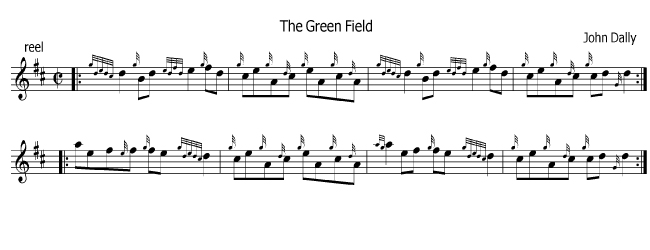Editor’s Note: John Dally of Burton, Washington has been playing bagpipes since the age of 11. Equally comfortable with Highland, Lowland and Northumbrian pipes and repertoire, this year John produced “The Northwest Collection of Music for the Scottish Highland Bagpipe. A Collection of Music, Photographs and Essays”. The book includes a fascinating history of pipers and piping in the northwestern US. John selected all, composed many and edited the 150 tunes, which are of course suitable for playing on Scottish smallpipes, Border Pipes and other melody instruments. In this article John shares his thoughts about including embellishments in his pipe tunes settings. The book is available from John (dirdum (at) gmail.com) for $29, postage included.
Why Embellish?
Is it better to include doublings, gracings and other embellishments, or to print tunes without them? My philosophical preference is to print just the melody notes , leaving embellishment up to the personal taste or, in Gaelic, blas of the piper. When it came to putting together the NORTHWEST COLLECTION, however, this question vexed me for several reasons.
Embellishments indicate rhythm, and every musician brings to a tune his or her own sense of rhythm. Many of the tunes in the collection would be diminished by rhythms commonly heard at Highland Games today. Although many of the tunes in the collection are suitable for bands, most are not suitable for solo competition, and the collection is designed for the non-competitive piper. Musical literacy is so refined in piping today that many pipers are put off by a score without embellishments. So I chose to include my own embellishments rather than leave them out. How I play any given tune changes over time, and I hope pipers who find my tunes interesting enough to learn will bring their own interpretation to them. In an ideal environment, we could learn tunes from the simplest notation. I decided to err on the side of too much information rather than too little. I hope pipers will see the settings as the beginning of a discussion rather the final word on how the tune should go.
The idea that there is only one way to embellish a tune or only one way to play it is not very interesting. The process of learning and playing a tune is fluid within the context of performance, mood and instrumentation. So I encourage musicians to freely interpret these settings, but to do so with respect for the melody, composer and tradition. It used to be a piper might comment on another piper’s playing by saying something like, “That’s not how I was taught to play it.” Thankfully, things are changing. More and more pipers are eager to hear new interpretations, new techniques, and encourage individual styles among their peers.
There are subtle rhythms in all piping, but how you use them or not is one of the things that distinguishes your blas and style. They are the source of “dirt” and character. One of my favorite movements is the “edre,” because you can play it at least three different ways: as a triplet, a quick grip-like movement, or a fierce “dre.” And even though I followed convention by writing the throw on ‘d’ with three notes, I play four, sometimes slightly holding onto the first low ‘g’ for emphasis. I opened up heavy movements like the taorluath, crunluath and crunluath a mach, sometimes adding in the so called “redundant low A” for rhythm. “The Bear on the Island” is a reel full of exploded heavy movements. On the other hand I treated “The Hen Wife’s Daughter” and “The Brown Haired Girl’s Reel” with the simplest possible gracings in a reaction to heavy competition style settings.
It is easy and fun to experiment with the subtle rhythms in tunes you already know by opening tachums, reversing the hold/cut tachums in strathspeys, playing birls open or replacing them with doublings. A grace note on the back of the beat rather than on the front is a good way to add shape. Opening up doublings or closing them down accentuates the subtle rhythms within a tune, the micro-rhythms.
While playing reels in a style influenced by Barry Shears, Allan MacDonald and others, a new embellishment came to me. I discovered it while trying to play something that sounds like an “edre” going from ‘d’ to an ‘e.’ You will find it in the reels “Dr. MacKinnon,” “The Fife Hunt,” “The Green Field” and a couple of other tunes. Exploded it looks like this: ‘e’, ‘d’, ‘f’, ‘d’ grace notes going from a ‘d’ eighth note to an ‘e’ quarter note. If you prefer you can replace the embellishment with a ‘d’ eighth note.
The pibroch “Anam Cara” employs several different embellishments inspired by old styles such as those found in General Thomason’s CEOL MOR and James MacColl’s ideas about pibroch. The movements have specific rhythms and to play them other than how they are printed will distort the character of the tune. They are no more difficult than common pibroch embellishments.
Embellishments are more than technically difficult flashes. You use them to enhance the subtle rhythmic underpinning of the melody. Listeners will respond to these subtleties without identifying them. They will applaud technical fireworks, they will remember the melody, but it is the rhythm that will move them.
-John Dally
